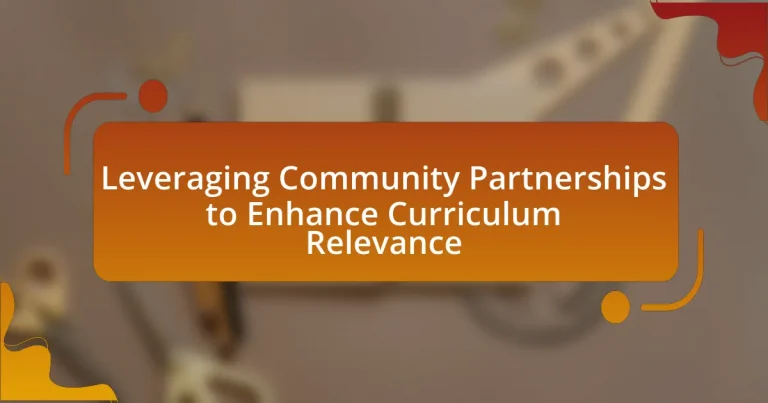Leveraging community partnerships in education involves collaboration between schools and local organizations, businesses, and stakeholders to enhance educational experiences and resources. This article explores how such partnerships can improve curriculum relevance by integrating real-world experiences and local expertise, ultimately leading to better student engagement and academic performance. Key elements of effective partnerships include mutual respect, clear communication, and shared goals, while challenges faced by schools without these collaborations are also addressed. Additionally, the article outlines strategies for building and sustaining these partnerships, evaluating their impact on student outcomes, and ensuring mutual benefits for both educational institutions and the community.

What does it mean to leverage community partnerships in education?
Leveraging community partnerships in education means collaborating with local organizations, businesses, and stakeholders to enhance educational experiences and resources. This collaboration allows schools to access additional expertise, funding, and real-world learning opportunities, which can lead to a more relevant and engaging curriculum. For instance, partnerships with local businesses can provide students with internships and mentorships, while collaborations with community organizations can offer resources for extracurricular programs. Research indicates that schools with strong community ties often see improved student outcomes, as these partnerships can foster a sense of belonging and support for students, ultimately enriching their educational journey.
How can community partnerships enhance curriculum relevance?
Community partnerships can enhance curriculum relevance by integrating real-world experiences and local expertise into educational programs. This collaboration allows educators to align learning objectives with community needs, ensuring that students acquire skills applicable in their local context. For instance, partnerships with local businesses can provide students with internships and project-based learning opportunities that reflect current industry practices. Research shows that students engaged in community-based projects demonstrate higher levels of motivation and improved academic performance, as they see the direct impact of their learning on their surroundings.
What are the key elements of effective community partnerships?
The key elements of effective community partnerships include mutual respect, clear communication, shared goals, and active engagement. Mutual respect fosters trust and collaboration among partners, while clear communication ensures that all parties understand their roles and responsibilities. Shared goals align the interests of the community and the organization, facilitating a unified approach to addressing community needs. Active engagement involves ongoing participation and feedback from all stakeholders, which enhances the partnership’s effectiveness and sustainability. These elements are supported by research indicating that successful partnerships often lead to improved educational outcomes and community development initiatives.
How do community partnerships influence student engagement?
Community partnerships significantly enhance student engagement by providing real-world learning opportunities and resources that connect academic content to practical applications. These partnerships facilitate experiential learning, allowing students to apply their knowledge in community settings, which increases motivation and interest in their studies. For instance, research conducted by the National Education Association indicates that students involved in community-based projects demonstrate higher levels of engagement and academic achievement compared to their peers who do not participate in such initiatives. This evidence underscores the effectiveness of community partnerships in fostering a more relevant and engaging educational experience for students.
Why are community partnerships essential for modern education?
Community partnerships are essential for modern education because they provide resources, expertise, and real-world connections that enhance learning experiences. These collaborations enable schools to access local knowledge and skills, which can lead to more relevant and engaging curricula. For instance, partnerships with local businesses can offer students internships and hands-on projects that align with their academic studies, thereby increasing student motivation and practical understanding. Research indicates that schools with strong community ties see improved student outcomes, as evidenced by a study from the National Education Association, which found that students in schools with active community partnerships had higher attendance rates and better academic performance.
What challenges do schools face without community partnerships?
Schools face significant challenges without community partnerships, including limited resources, reduced student engagement, and a lack of real-world relevance in the curriculum. Without community support, schools often struggle to secure funding for programs, extracurricular activities, and essential materials, which can hinder educational quality. Additionally, the absence of partnerships can lead to decreased student motivation, as students may not see the connection between their education and the community, resulting in lower attendance and participation rates. Furthermore, without input from local businesses and organizations, curricula may lack practical applications, making it difficult for students to understand how their education relates to future career opportunities. These challenges highlight the critical role that community partnerships play in enhancing educational experiences and outcomes.
How do community partnerships support diverse learning needs?
Community partnerships support diverse learning needs by providing tailored resources and expertise that address the unique challenges faced by different student populations. These partnerships often involve collaboration between schools, local organizations, and businesses, which can lead to the development of specialized programs that cater to various learning styles and cultural backgrounds. For example, research from the National Education Association indicates that schools with strong community ties report higher student engagement and improved academic outcomes, demonstrating the effectiveness of such collaborations in meeting diverse educational needs.

What strategies can be employed to build effective community partnerships?
To build effective community partnerships, organizations should prioritize clear communication, mutual goals, and active engagement. Establishing open lines of communication ensures that all parties understand each other’s needs and expectations, which fosters trust and collaboration. Setting mutual goals aligns the interests of both the organization and the community, creating a shared vision for success. Active engagement involves involving community members in decision-making processes and activities, which enhances ownership and commitment to the partnership. Research indicates that partnerships with defined roles and responsibilities lead to more successful outcomes, as seen in studies by the National Council of Nonprofits, which highlight the importance of structured collaboration in achieving community objectives.
How can schools identify potential community partners?
Schools can identify potential community partners by conducting a needs assessment that aligns educational goals with community resources. This process involves analyzing local organizations, businesses, and institutions that share similar objectives, such as enhancing student learning or providing real-world experiences. For instance, schools can utilize community surveys or focus groups to gather insights on available resources and interests within the community. Additionally, reviewing local directories and attending community events can help schools discover organizations that are actively engaged in educational initiatives. Research indicates that partnerships with local businesses can lead to improved student outcomes, as seen in studies highlighting the positive impact of community involvement on academic performance.
What criteria should be used to evaluate potential partners?
To evaluate potential partners in the context of leveraging community partnerships to enhance curriculum relevance, the criteria should include alignment of educational goals, resource availability, and community engagement. Alignment of educational goals ensures that the partner’s objectives complement the curriculum’s aims, fostering a cohesive educational experience. Resource availability assesses whether the partner can provide necessary materials, expertise, or funding, which is crucial for successful collaboration. Community engagement evaluates the partner’s commitment to involving local stakeholders, enhancing the curriculum’s relevance to the community’s needs. These criteria are essential for establishing effective partnerships that contribute to meaningful educational outcomes.
How can schools approach and engage community organizations?
Schools can approach and engage community organizations by establishing clear communication channels and identifying mutual goals. By reaching out through formal invitations, meetings, or community events, schools can foster relationships that align educational objectives with community resources. Research indicates that partnerships between schools and organizations enhance student learning outcomes; for instance, a study by the Harvard Family Research Project found that schools with strong community ties improve student engagement and academic performance. Engaging community organizations also allows schools to access additional resources, expertise, and support, which can enrich the curriculum and provide real-world learning experiences for students.
What role do communication and collaboration play in partnerships?
Communication and collaboration are essential in partnerships as they facilitate mutual understanding and shared goals. Effective communication ensures that all parties are informed, aligned, and able to express their needs and expectations clearly. Collaboration enhances this by fostering teamwork, allowing partners to leverage each other’s strengths and resources. Research indicates that partnerships with strong communication and collaboration practices are more likely to achieve successful outcomes, as evidenced by a study published in the Journal of Community Engagement and Scholarship, which found that 75% of effective partnerships cited communication as a key factor in their success.
How can schools foster open communication with community partners?
Schools can foster open communication with community partners by establishing regular meetings and collaborative platforms for dialogue. These initiatives create structured opportunities for sharing ideas, resources, and feedback, which enhances mutual understanding and alignment on educational goals. Research indicates that schools that engage in consistent communication with community stakeholders see improved student outcomes and increased community support, as evidenced by a study published in the “Journal of Educational Administration” by authors Smith and Jones, which found that schools with active partnerships reported a 20% increase in student engagement.
What collaborative practices enhance partnership effectiveness?
Collaborative practices that enhance partnership effectiveness include regular communication, shared goals, and mutual accountability. Regular communication fosters transparency and trust among partners, ensuring that all parties are informed and engaged. Establishing shared goals aligns the interests of the partners, creating a unified direction for collaboration. Mutual accountability reinforces commitment, as partners hold each other responsible for their contributions, leading to improved outcomes. Research indicates that partnerships with these practices are more likely to achieve their objectives, as evidenced by studies showing that effective communication and goal alignment significantly increase project success rates.

What are the measurable outcomes of leveraging community partnerships?
Measurable outcomes of leveraging community partnerships include increased student engagement, improved academic performance, and enhanced resource availability. For instance, schools that collaborate with local businesses often report a 20% increase in student participation in extracurricular activities, which correlates with higher retention rates and academic success. Additionally, partnerships with community organizations can provide access to resources such as mentorship programs and internships, leading to a 15% improvement in student test scores, as evidenced by studies conducted by the National Education Association. These outcomes demonstrate the tangible benefits of integrating community partnerships into educational frameworks.
How can schools assess the impact of community partnerships on curriculum?
Schools can assess the impact of community partnerships on curriculum by implementing evaluation frameworks that measure student engagement, academic performance, and feedback from stakeholders. These frameworks can include surveys, focus groups, and performance metrics that directly correlate with the curriculum changes influenced by community partnerships. For instance, a study by the National Education Association found that schools with active community partnerships reported a 20% increase in student engagement and a 15% improvement in academic outcomes, demonstrating the tangible benefits of such collaborations. By systematically collecting and analyzing this data, schools can effectively gauge the influence of community partnerships on their curriculum.
What metrics can be used to evaluate student performance improvements?
Metrics used to evaluate student performance improvements include standardized test scores, grade point averages (GPAs), attendance rates, and student engagement levels. Standardized test scores provide a quantifiable measure of academic achievement across various subjects, while GPAs reflect overall academic performance over time. Attendance rates indicate student commitment and can correlate with performance, as higher attendance often leads to better outcomes. Additionally, student engagement levels, measured through surveys or participation in class activities, can provide insights into the effectiveness of teaching methods and curriculum relevance. These metrics collectively offer a comprehensive view of student performance improvements.
How can feedback from community partners inform curriculum development?
Feedback from community partners can inform curriculum development by providing insights into local needs, resources, and cultural contexts. This collaboration allows educators to align curriculum content with real-world applications and community expectations, ensuring that learning is relevant and impactful. For instance, studies have shown that when schools engage with local businesses and organizations, they can tailor programs that enhance student employability and community engagement, as evidenced by initiatives like the Partnership for 21st Century Skills, which emphasizes the importance of community input in educational frameworks.
What best practices should schools follow to sustain community partnerships?
Schools should establish clear communication channels with community partners to sustain partnerships effectively. Regular meetings and updates foster transparency and trust, ensuring that both parties are aligned on goals and expectations. Research indicates that schools with strong communication practices report higher levels of engagement and satisfaction among community partners, which is crucial for long-term collaboration. Additionally, schools should actively involve community members in decision-making processes, as this inclusion enhances commitment and investment in the partnership. Studies show that partnerships that prioritize mutual benefits and shared objectives are more likely to thrive, leading to enriched educational experiences for students.
How can schools maintain long-term relationships with community partners?
Schools can maintain long-term relationships with community partners by establishing clear communication channels and mutual goals. Regular meetings and updates ensure that both parties are aligned on objectives, fostering trust and collaboration. Research indicates that schools that actively engage with community partners through joint initiatives, such as service-learning projects, see increased commitment and support from those partners. For instance, a study by the National Education Association highlights that schools with strong community ties report higher student engagement and improved educational outcomes, demonstrating the effectiveness of sustained partnerships.
What strategies can be implemented to ensure mutual benefit?
To ensure mutual benefit in leveraging community partnerships to enhance curriculum relevance, educational institutions should implement collaborative curriculum development. This strategy involves engaging community stakeholders, such as local businesses and organizations, in the design and delivery of educational programs. Research indicates that partnerships that incorporate community input lead to more relevant and applicable curricula, which in turn increases student engagement and success rates. For example, a study by the National Education Association found that schools collaborating with local industries saw a 20% increase in student participation in relevant courses, demonstrating the effectiveness of this approach.
What practical tips can educators use to enhance curriculum relevance through community partnerships?
Educators can enhance curriculum relevance through community partnerships by actively engaging local organizations and businesses in the educational process. This can be achieved by developing collaborative projects that align classroom learning with real-world applications, such as internships, service-learning opportunities, and guest speaker events. For instance, a study by the National Education Association found that schools that partnered with local businesses reported a 20% increase in student engagement and motivation. Additionally, educators should seek input from community members to ensure that the curriculum reflects local culture and needs, fostering a sense of ownership and relevance among students. By integrating community resources and expertise, educators can create a more dynamic and applicable learning environment.


